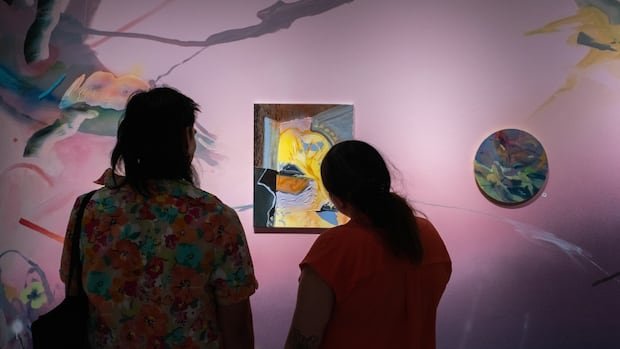The tiny humans in this photo highlight the magnitude of the snake body in this Colombian rock art. … [+]
At least 2,000 years ago, people living along South America’s Orinoco River carved symbols into rocks—human figures, geometric shapes, birds, centipedes. And snakes, lots of giant snakes. One such slithering subject measures more than 130 feet long, which likely makes it the largest rock art ever discovered.
But it’s not just the size of that and other serpents etched near the Orinoco that’s captivated scientists. It’s why they were drawn at such a scale in the first place. Their conclusion: The creatures, believed to be boa constrictors or anacondas, probably functioned as physical markers that could be seen from great distances.
“We believe the engravings could have been used by prehistoric groups as a way to mark territory, letting people know that this is where they live and that appropriate behavior is expected,” said Philip Riris, a lecturer in archaeology at Bouremouth University in the U.K. and lead author of the study according to researchers who analyzed the dominant snake motifs at a series of rock art sites, published Tuesday in the journal Antiquity. Riris and his fellow researchers want to better understand the connection between prehistoric art practices and indigenous world views.
Snakes, which feature prominently in indigenous creation myths and cosmologies across northern South America, are generally interpreted as threatening, Riris added in a statement. “So where the rock art is located could be a signal that these are places where you need to mind your manners,” he said.
An artistic impression of a mythical snake traversing the Orinoco River. Serpents figure heavily … [+]
Prehistoric rock art, which has been discovered in Australia, Borneo, Brazil, India, South Africa, Amazonian rainforests, among other places, has much to reveal about our predecessors, including insights into their levels of sophistication, the objects of their fascination and astronomical phenomena they may have witnessed. One stone carving from thousands of years back appears to depict humans’ amazement at a supernova.
The large-scale rock art described in the Antiquity study appears in a region spanning the Colombian-Venzuelan border called the Atures Rapids. Other archaeological finds show the area would have been key to prehistoric trade and travel.
“This means it would have been a key point of contact, and so making your mark could have been all the more important because of that, marking out your local identity and letting visitors know that you are here,” study co-author José Oliver, a University College specialist in Latin American archaeology, said in a statement.
Adam Brumm, an archaeologist at Australia’s Griffith University who was not involved with the Orinico research, agrees with the study’s hypothesis that the gigantic snakes shallowly etched into the riverside rocks likely reflect indigenous creation myths and cosmology. He says their location close to water could also reflect a belief in the “rainbow serpent,” an immortal ancestral being that appears in Aboriginal and other ancient mythology.
The association between snakes and water “is thought to come from humans observing rainbows appearing at waterfalls, rapids, deep pools and so on and interpreting these arching, snake-like forms as supernatural serpents of enormous size and power that dwelt in those water sources,” Brumm said in an interview. “I would not be surprised to find that indigenous creation myths from the Orinoco River area contain references to this symbolic interconnection between rainbows and water and cultural images of huge snakes.”
An enhanced image of monumental rock art on Cerro Pintado in Venezuela shows a huge snake surrounded … [+]
The study labels the rock art it describes as “monumental.” That means it’s really, really big, yes, but monumental is also archaelogical parlance for rock art more than 13 feet wide or high. Since 2015, Riris and fellow researchers have mapped 14 monumental rock art sites using DSLR cameras and drones. The Orinico engravings are “several times larger” than other massive rock art found in Arabia, Norway and Niger, Riris said in an email.
While it’s hard to date rock engravings, the motifs that appear in the Orinoco carvings show up in smaller rock art from around 2,000 years ago, indicating a shared symbolic vocabulary. One zigzagging snake with horns mimics a serpent seen on a ceramic vessel from around the same place and time.
The researchers say it’s crucial that these and other monumental rock art sites are preserved as visual records of the past. They’ve registered the sites with Colombian and Venezuelan national heritage bodies.
“Some of the communities around the sites feel a very strong connection to the rock art,” study co-author Natalia Lozada Mendieta of Universidad de los Andes, said in a statement. “Moving forward, we believe they are likely to be the best custodians.”
A north-facing view of the Orinoco River from the Colombian side, taken from the summit of a granite … [+]






